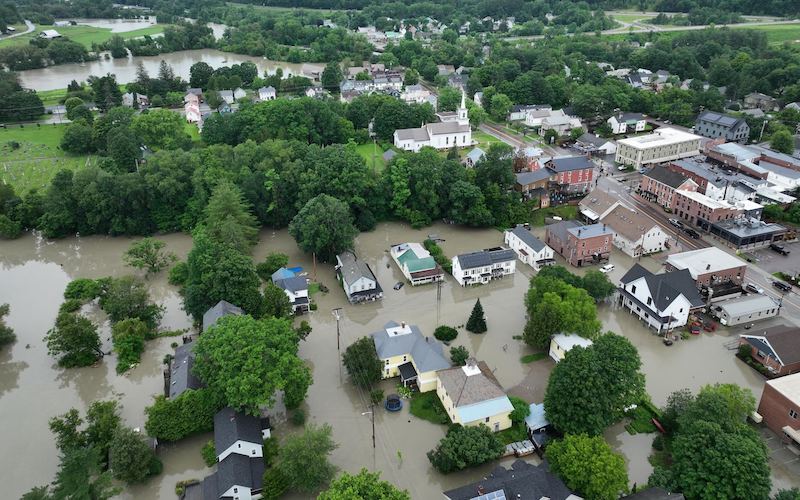
In the summer of 2023, towns around Vermont suffered devastating flooding as a result of climate change. Photo: Vince Franke
Torrential rains. Devastating floods. Hazy smoke from Canadian wildfires. One of the most prolonged heatwaves on record in the Southwest.
This summer has been nothing if not a summer of cataclysmic news about catastrophic weather events. Here in New England, Vermonters are grappling with the destruction wrought by powerful floods rivaling those following Hurricane Irene in 2011. Towns in Connecticut, Rhode Island, and New York were also inundated after two months’ worth of rainfall fell in some areas in a matter of a few hours.
If this weren’t all incomprehensibly extreme enough, there has been even more to process: Outside New England, calamitous floods have swept through Delhi and Spain. The tiny far north town of Norman Wells, Canada, near the Arctic Circle, hit 100 degrees last week. Record-breaking 96-degree ocean water swirled about the Florida Keys.
The spate of apocalyptic news is, frankly, overwhelming. Our hearts go out not only to friends and family in New England who have been affected by disastrous flooding but to those around the country and world who have lost homes, loved ones, and livelihoods to wildfires, extreme heat, landslides, and floods. We also grieve what we see happening to our planet – the destruction of the coral reef due to tepid ocean waters, the loss of marine life because of toxic algae outbreaks, the loss of precious Canadian forests that serve as home to many plants and animals and that are a critical part of the carbon cycle.
But after a pause to process the summer events, we must pull ourselves out of our collective despair and get busy doing the work that needs to be done. And it’s no mystery what it is. We know that climate change is fueling the extreme weather we see unfolding around us. A warmer atmosphere holds more moisture, resulting in the deluge of rain we’ve just experienced in New England. And our atmosphere is warming because of our use of fossil fuels. (Disgracefully, oil companies have known since the 1970s that fossil fuels were heating our planet, and they’ve continued to peddle them anyway, despite the consequences.)
Getting Serious About Carbon Emissions
We must mount an all-out offensive on two fronts: first, we must pressure our leaders to decarbonize as quickly as possible by embracing clean energy, electric vehicles, heat pumps, and public transit while simultaneously building out an electrical grid and new transmission lines capable of handling all the new clean energy. Federal, state, and local officials must offer residents greater incentives and assistance to help convert their homes to electric heating and cooling. Officials must work to get more solar and wind projects built in New England and off our coast. Fossil fuel companies need to stop hi-jacking clean energy progress with greenwashing stalling tactics, change their business model, and become part of a real solution.
Preparing for What’s Here Now
But we can’t stop there. Just as important, we must demand that state, city, and town officials do a much better job of preparing for the extreme weather events we already have and for those we know are coming our way. Our federal flood maps, used as a guide to where to build housing and infrastructure, are woefully outdated. Consequently, many areas deemed “safe” from floods are at risk. According to data from the First Street Foundation, the true number of homes at risk from flooding in Vermont is three times higher than the federal flood maps show. This must be fixed.
The country also needs a comprehensive, updated national precipitation database to help city planners, as well as homeowners, assess their risk for flooding. Our current 60-year-old database is inadequate. Our leaders should be spending more on modeling and planning for floods like those in Vermont because we know intense rainfall will happen more frequently.
As federal, state, and local planners bolster their flood planning, city planners must consider how our cities and towns can be modified to absorb runoff after heavy rains. This may mean building more parks strategically located to serve as giant sponges in a neighborhood. It may also mean allowing land that was once wetlands to return to its original state. And we need to protect critical infrastructure – from the electricity grid to public transit – to ensure it is resilient to increasingly frequent and severe storms.
Some Good News, Too
Fortunately, much of the work that needs to be done has already started. Federal action like the Inflation Reduction Act includes mandates to ramp up clean energy development and climate preparedness efforts. Local action here at home has made Massachusetts and New England climate leaders. CLF is dedicated to keeping it that way by pressuring states to update their carbon emissions targets, electrify public and private transit, and retrofit existing buildings for clean energy. We’re also working on climate resilience, by, for instance, pushing for better regulation of development in river corridors in Vermont and getting more trees planted in hot urban zones to help residents endure extreme heat in New Hampshire. We’re calling on utility companies across the region to better prepare their infrastructure to withstand extreme events like we’ve just seen. We know what’s at stake and what’s coming, and we’re working furiously to prepare.
Although this summer’s climate news may seem daunting, the answer is not despair. We must use the recent weather events as an opportunity to double down on efforts in our own communities to make a difference. Together, with resolve, we can work to turn things around.




